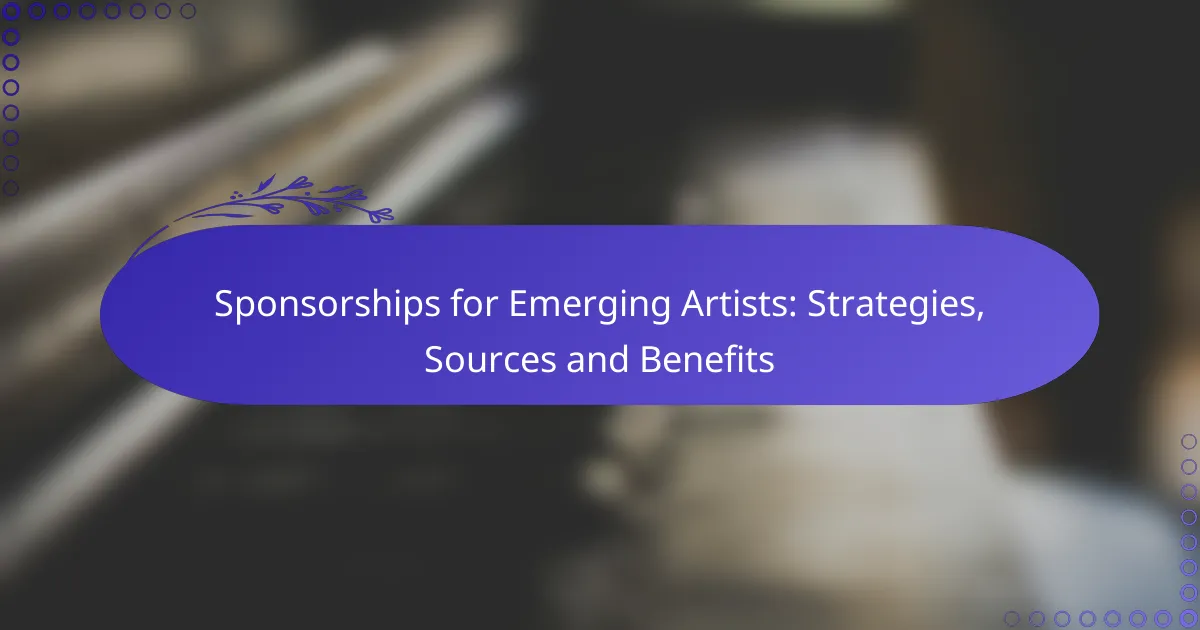Sponsorships play a crucial role in the development of emerging artists by providing essential financial support and resources. By utilizing effective strategies and exploring diverse sources, artists can enhance their visibility and career prospects. The benefits of sponsorship not only include funding but also valuable networking opportunities that can significantly impact their journey in the competitive art industry.
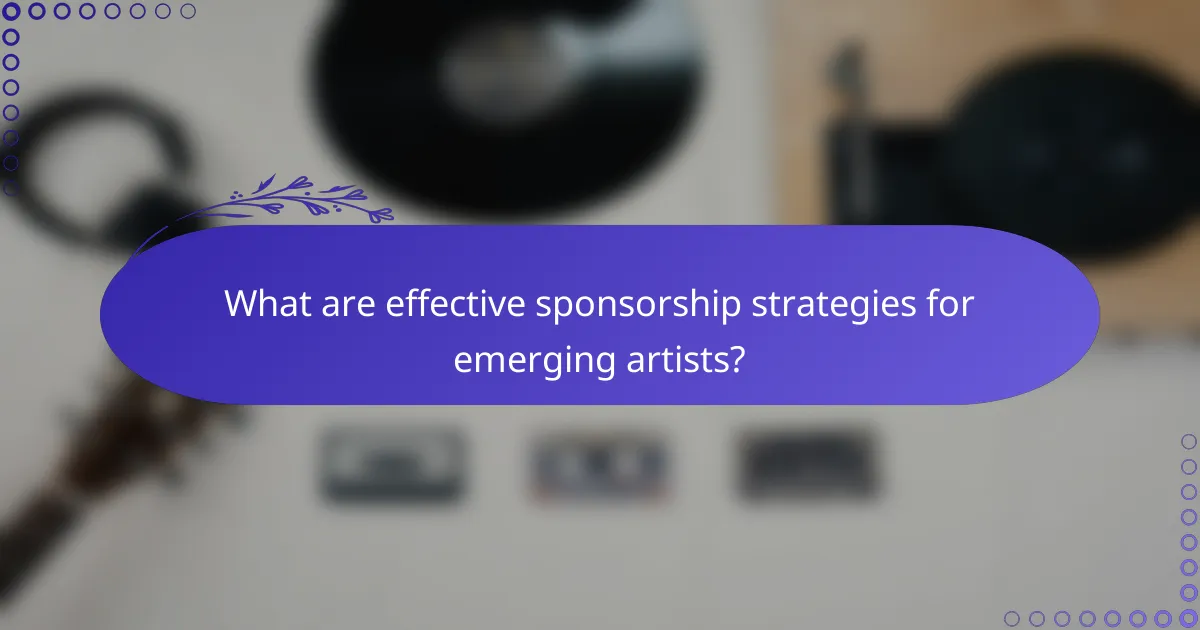
What are effective sponsorship strategies for emerging artists?
Effective sponsorship strategies for emerging artists involve building strong relationships, leveraging digital platforms, and crafting compelling proposals. These strategies help artists secure financial support and resources that can enhance their visibility and career growth.
Building partnerships with local businesses
Emerging artists can benefit significantly from forming partnerships with local businesses. These collaborations can provide mutual benefits, such as increased exposure for both the artist and the business, often leading to co-hosted events or exhibitions.
To initiate these partnerships, artists should identify businesses that align with their artistic vision and values. Approaching them with a clear proposal that outlines potential benefits can help in securing sponsorship.
Utilizing social media for outreach
Social media platforms are powerful tools for emerging artists to reach potential sponsors. By showcasing their work and engaging with followers, artists can build a community that attracts the attention of businesses and sponsors.
Regularly posting content, such as behind-the-scenes looks at their creative process or upcoming projects, can enhance visibility. Additionally, using targeted ads can help reach specific demographics that may be interested in sponsoring art initiatives.
Engaging with art organizations
Connecting with local and national art organizations can open doors for sponsorship opportunities. These organizations often have established networks and resources that can benefit emerging artists.
Artists should actively participate in workshops, exhibitions, and networking events hosted by these organizations. Building relationships with key figures can lead to sponsorships or grants that support their artistic endeavors.
Creating compelling sponsorship proposals
A well-crafted sponsorship proposal is crucial for attracting potential sponsors. It should clearly outline the artist’s vision, the benefits to the sponsor, and how the partnership will be executed.
Including specific details such as audience demographics, marketing plans, and potential reach can make the proposal more appealing. Tailoring each proposal to align with the sponsor’s goals increases the chances of securing support.
Leveraging crowdfunding platforms
Crowdfunding platforms provide an alternative avenue for emerging artists to secure funding. By presenting their projects on sites like Kickstarter or Indiegogo, artists can reach a broader audience interested in supporting the arts.
Successful crowdfunding campaigns often include engaging videos, clear funding goals, and enticing rewards for backers. Artists should promote their campaigns through social media and personal networks to maximize reach and funding potential.
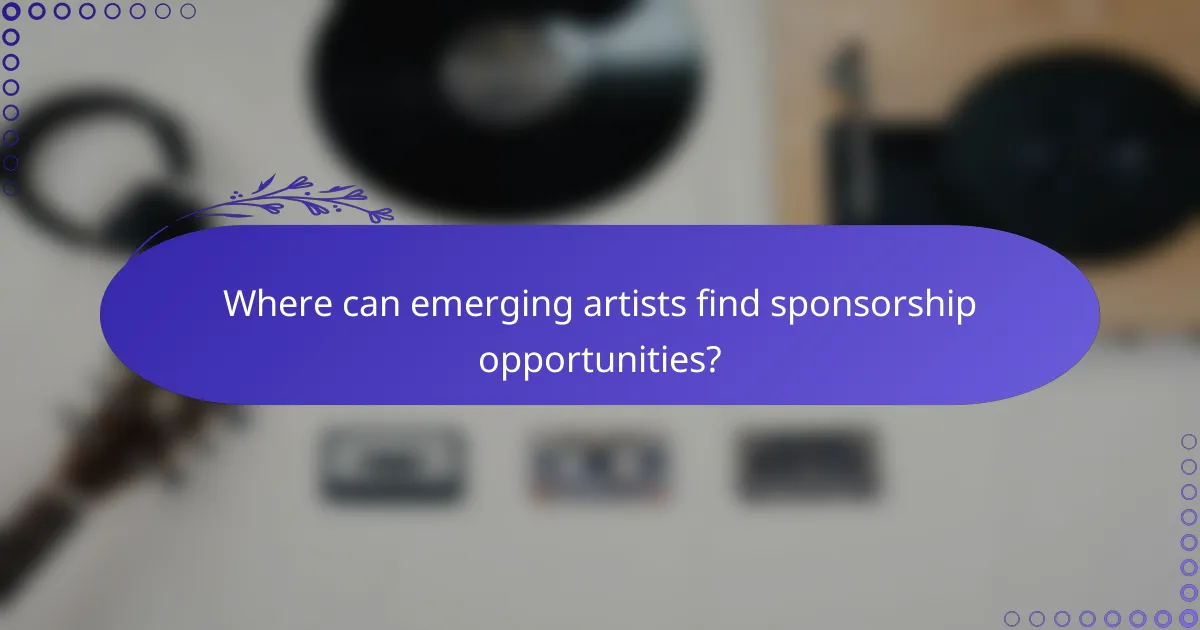
Where can emerging artists find sponsorship opportunities?
Emerging artists can find sponsorship opportunities through various channels, including local events, community foundations, corporate programs, and online platforms. Each source offers unique benefits and considerations, making it essential for artists to explore multiple avenues to secure funding and support.
Local art festivals and events
Local art festivals and events often provide sponsorship opportunities for emerging artists to showcase their work. These gatherings typically attract community members and art enthusiasts, creating a vibrant platform for exposure. Artists can apply for booth space or participate in competitions, which may include cash prizes or grants.
To maximize chances of securing sponsorship, artists should research upcoming festivals, prepare a compelling portfolio, and network with organizers and attendees. Participating in these events can also lead to valuable connections with potential sponsors.
Community foundations and grants
Community foundations frequently offer grants specifically aimed at supporting local artists. These organizations typically focus on enhancing cultural development within their regions and may provide financial assistance for projects, exhibitions, or educational programs. Artists should check eligibility criteria and application deadlines to ensure they meet the requirements.
Applying for grants often involves submitting a proposal that outlines the project’s goals, budget, and expected impact. Artists should emphasize how their work contributes to the community and consider collaborating with other local creatives to strengthen their applications.
Corporate sponsorship programs
Many corporations have sponsorship programs designed to support local artists and cultural initiatives. These programs may provide funding, resources, or promotional support in exchange for brand visibility at events or through artist collaborations. Emerging artists should identify companies that align with their values and artistic vision.
When approaching potential corporate sponsors, artists should prepare a clear pitch that outlines the benefits of collaboration, such as audience reach and brand engagement. Building relationships with local businesses can also lead to long-term partnerships that extend beyond initial sponsorships.
Online platforms like Patreon
Online platforms like Patreon enable emerging artists to connect directly with their audience and receive financial support through subscriptions. By offering exclusive content, behind-the-scenes access, or personalized rewards, artists can cultivate a loyal fan base willing to contribute monthly. This model provides a steady income stream that can supplement other funding sources.
To succeed on platforms like Patreon, artists should actively engage with their supporters and consistently deliver high-quality content. Setting clear goals and sharing progress can motivate patrons to continue their support, making it essential to maintain open communication and showcase the impact of their contributions.
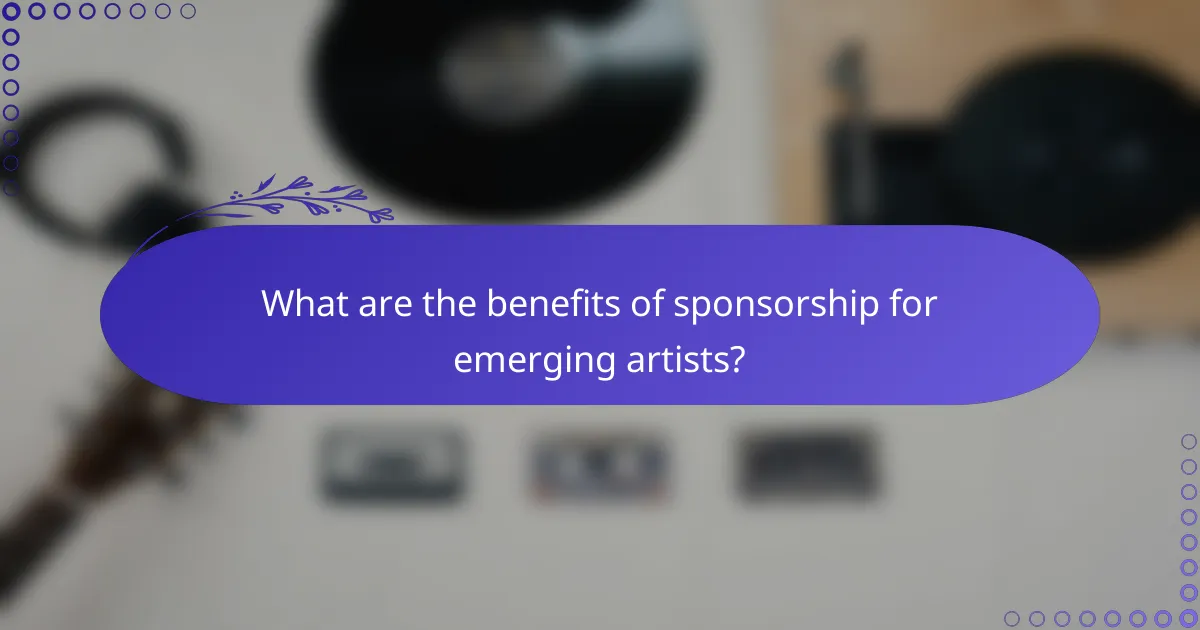
What are the benefits of sponsorship for emerging artists?
Sponsorship offers emerging artists significant advantages, including enhanced visibility, access to financial support, and valuable networking opportunities. These benefits can help artists establish their careers and gain a foothold in the competitive art industry.
Increased visibility and exposure
One of the primary benefits of sponsorship is the increased visibility and exposure it provides to emerging artists. Sponsors often promote their sponsored artists through various channels, including social media, events, and exhibitions, which can significantly broaden an artist’s audience.
For example, an artist sponsored by a well-known brand may have their work featured in high-profile galleries or events, attracting attention from collectors and critics alike. This exposure can lead to more opportunities and sales, making it a crucial aspect of an artist’s growth.
Access to funding and resources
Sponsorship can also provide emerging artists with essential funding and resources that may otherwise be out of reach. Financial support from sponsors can cover production costs, materials, and even living expenses, allowing artists to focus on their craft without financial strain.
Additionally, sponsors may offer resources such as studio space, marketing assistance, or access to professional development programs. These resources can be invaluable for artists looking to refine their skills and expand their reach.
Networking opportunities with industry professionals
Sponsorship often opens doors to networking opportunities with industry professionals, including curators, gallery owners, and other artists. These connections can lead to collaborations, mentorships, and invitations to exclusive events that can further enhance an artist’s career.
For instance, a sponsored artist might be invited to participate in a panel discussion or workshop, providing a platform to showcase their work and ideas. Building a strong network is essential for emerging artists, as it can lead to future sponsorships and career advancements.
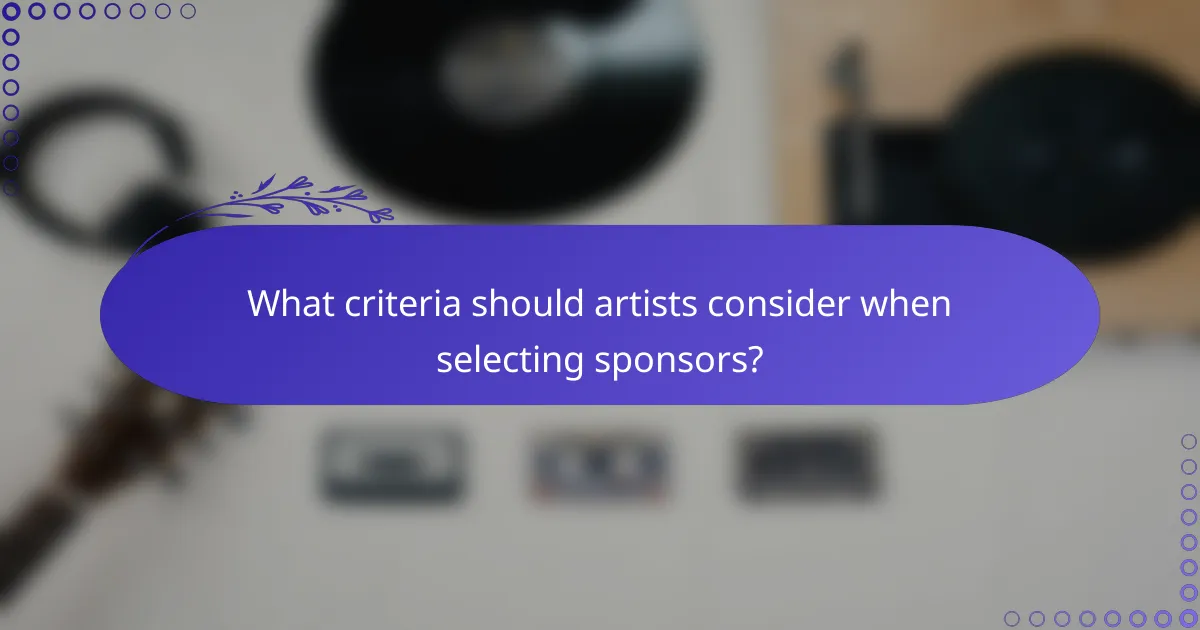
What criteria should artists consider when selecting sponsors?
Artists should evaluate several key criteria when selecting sponsors to ensure a mutually beneficial partnership. These criteria include alignment of values, compatibility with the target audience, and the sponsor’s reputation and credibility.
Alignment of values and mission
Choosing sponsors whose values and mission align with those of the artist is crucial for authenticity. When both parties share similar goals, it fosters a genuine partnership that resonates with audiences. For example, an artist focused on environmental issues should seek sponsors who prioritize sustainability.
To assess alignment, artists can research potential sponsors’ initiatives and past campaigns. This helps in identifying whether the sponsor’s actions reflect their stated values. A misalignment can lead to public backlash and damage both the artist’s and sponsor’s reputations.
Target audience compatibility
Understanding the compatibility of the sponsor’s target audience with the artist’s fan base is essential. A sponsor whose products or services appeal to the artist’s followers can enhance engagement and drive sales. For instance, a musician with a young audience may benefit from partnering with a trendy clothing brand.
Artists should analyze demographic data and audience interests to ensure a good fit. Tools like social media analytics can provide insights into the artist’s audience, helping to identify sponsors that align with those characteristics.
Reputation and credibility of the sponsor
The reputation and credibility of potential sponsors can significantly impact an artist’s brand. Partnering with a well-respected sponsor can enhance the artist’s image, while a sponsor with a negative reputation may harm it. Artists should conduct thorough research on potential sponsors’ histories and public perceptions.
Checking online reviews, news articles, and social media sentiment can provide valuable insights into a sponsor’s standing. Additionally, artists should consider the sponsor’s previous partnerships and how those collaborations were perceived by the public.

How can emerging artists measure the success of sponsorships?
Emerging artists can measure the success of sponsorships by evaluating audience engagement, financial support, and the impact of brand partnerships. These metrics provide insights into how effectively the sponsorships are contributing to the artist’s growth and visibility.
Tracking audience engagement metrics
Monitoring audience engagement is crucial for understanding the effectiveness of sponsorships. Key metrics include social media interactions, website traffic, and attendance at events. For instance, a spike in social media followers or increased event attendance after a sponsorship can indicate positive engagement.
Artists should consider using analytics tools to track these metrics over time. Regularly reviewing engagement data helps identify trends and areas for improvement, allowing artists to adjust their strategies accordingly.
Evaluating financial support received
Assessing the financial support from sponsorships involves tracking direct funding and any additional resources provided. This can include cash contributions, in-kind support, or promotional assistance. Artists should maintain clear records of all financial transactions related to their sponsorships.
Comparing the total financial support against the costs incurred during projects can help determine the return on investment. Artists should aim for a clear understanding of how sponsorship funds are being utilized to maximize their impact.
Assessing brand partnerships impact
Evaluating the impact of brand partnerships involves analyzing how these collaborations enhance the artist’s visibility and reputation. Artists should consider factors such as brand alignment, audience reach, and the overall perception of the partnership within their community.
Gathering feedback from audiences and stakeholders can provide valuable insights into how brand partnerships are perceived. Additionally, artists can assess whether these partnerships lead to new opportunities, such as collaborations or increased sales, further indicating their success.
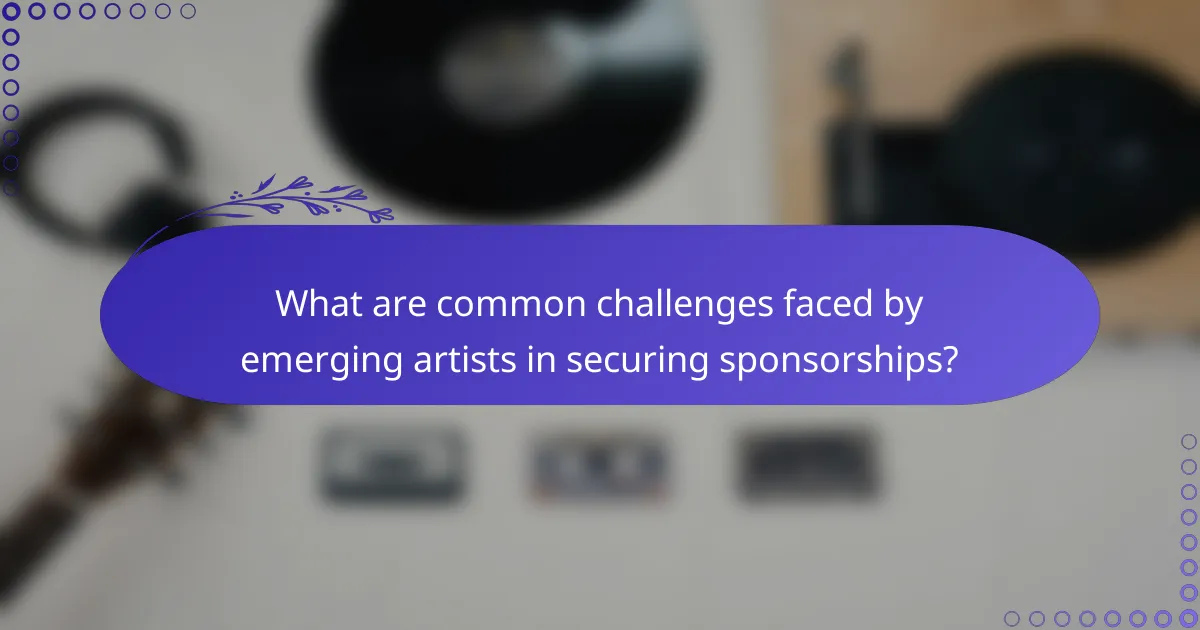
What are common challenges faced by emerging artists in securing sponsorships?
Emerging artists often encounter several challenges when trying to secure sponsorships, including limited visibility, lack of established networks, and difficulties in demonstrating return on investment for potential sponsors. These obstacles can hinder their ability to attract funding and support for their creative projects.
Limited visibility and recognition
Many emerging artists struggle with limited visibility in a crowded market. Without a strong portfolio or a significant following, it can be challenging to catch the attention of potential sponsors. Building an online presence through social media and showcasing work in local galleries can help increase recognition.
Lack of established networks
Networking is crucial in the art world, yet emerging artists often lack connections with industry professionals. Attending art fairs, workshops, and community events can help build relationships with potential sponsors and other artists. Collaborating with more established artists can also provide valuable introductions.
Demonstrating value to sponsors
Emerging artists may find it difficult to prove their potential return on investment to sponsors. Creating a clear value proposition that outlines audience reach, engagement metrics, and past successes can help. Developing a professional sponsorship proposal that includes specific goals and benefits for the sponsor is essential.
Understanding sponsorship expectations
Different sponsors have varying expectations regarding sponsorship agreements. Emerging artists should research potential sponsors to understand their goals and how they align with their own projects. Clear communication about what each party expects can prevent misunderstandings and foster successful partnerships.
